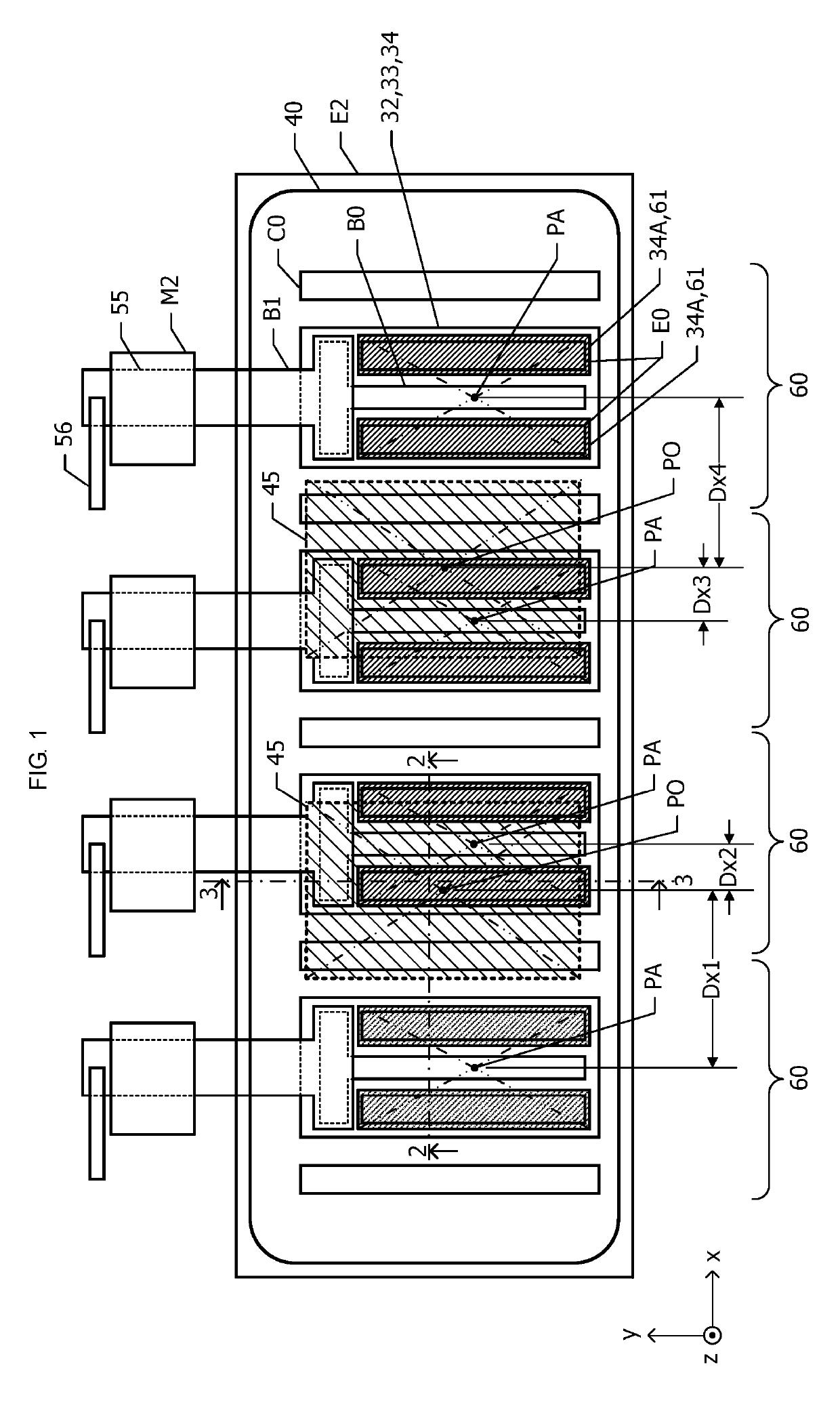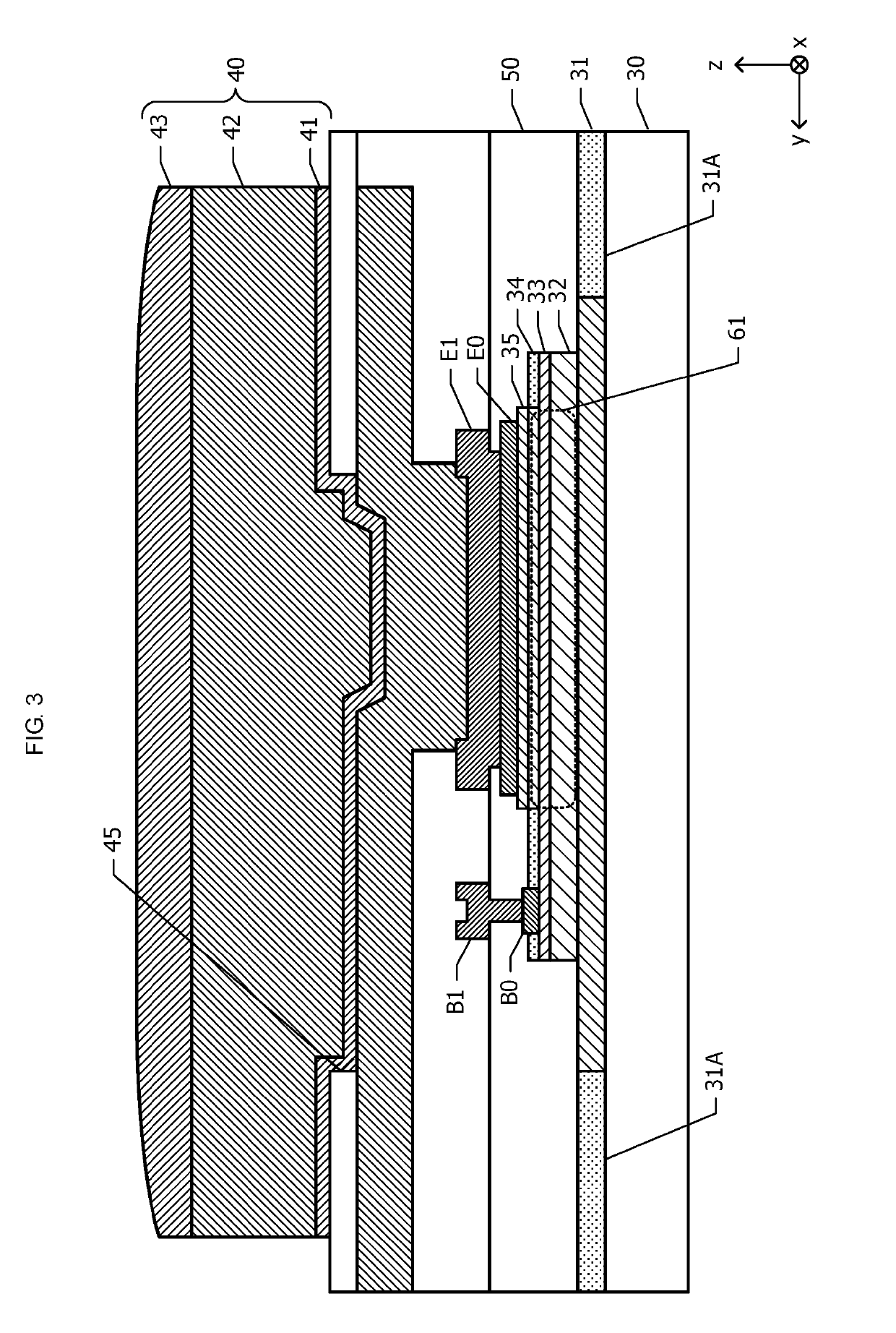Semiconductor apparatus
a technology of semiconductor apparatus and semiconductor atomizer, which is applied in the direction of electrical apparatus, semiconductor device details, semiconductor/solid-state device devices, etc., can solve the problems of short life of the overall semiconductor apparatus, inability to uniformize the temperature of the unit transistor, and reduce the radio-frequency characteristics of the semiconductor apparatus. , to achieve the effect of reducing the temperature difference and reducing the non-uniform temperatur
- Summary
- Abstract
- Description
- Claims
- Application Information
AI Technical Summary
Benefits of technology
Problems solved by technology
Method used
Image
Examples
first embodiment
[0048]A semiconductor apparatus according to a first embodiment will be described below with reference to FIGS. 1 through 5B.
[0049]FIG. 1 is a plan view illustrating the layout of the elements forming the semiconductor apparatus according to the first embodiment. FIG. 2 is a sectional view taken along the long-dashed dotted line 2-2 in FIG. 1. FIG. 3 is a sectional view taken along the long-dashed dotted line 3-3 in FIG. 1. The semiconductor apparatus is constituted by plural elements stacked on each other. To make it easy to differentiate the elements of the semiconductor apparatus, some elements located on the lower side and hidden under the elements on the upper side are indicated by the broken lines, though they are not actually seen from above in FIG. 1. The outer edges of some elements are indicated by the broken lines, and some elements are indicated by the hatched portions with different densities.
[0050]In the drawings, an xyz rectangular coordinate system is defined. In thi...
second embodiment
[0106]A semiconductor apparatus according to a second embodiment will be described below with reference to FIG. 6. An explanation of the elements configured in the same manner as those of the first embodiment will be omitted.
[0107]FIG. 6 is a plan view illustrating the layout of the elements forming the semiconductor apparatus according to the second embodiment. In the second embodiment, three unit transistors 60 are arranged in the x-axis direction. However, four unit transistors 60 may be provided, as in the first embodiment, or two or five or more unit transistors 60 may be provided. In the first embodiment, one unit transistor 60 includes two emitter regions 34A (FIGS. 1 and 2). In the second embodiment, one unit transistor 60 includes one emitter region 34A, that is, one unit transistor 60 includes one operating region 61. The operating region 61 is defined by the outer edge lines of the emitter region 34A for each unit transistor 60. In FIG. 6, the operating regions 61 are ind...
third embodiment
[0111]A semiconductor apparatus according to a third embodiment will be described below with reference to FIGS. 7 through 11. An explanation of the elements configured in the same manner as those of the first embodiment will be omitted. The semiconductor apparatus of the third embodiment is a power amplifier module using the plural unit transistors 60 (FIG. 1) of the first embodiment as amplifiers.
[0112]FIG. 7 is an equivalent circuit diagram of a power amplifier circuit implemented by the semiconductor apparatus according to the third embodiment. The power amplifier circuit in the third embodiment amplifies an input signal in a radio-frequency band and outputs an amplified signal. The frequency of the input signal is in a range of several hundreds of megahertz (about 600 MHz, for example) to several dozens of gigahertz (60 GHz, for example).
[0113]The power amplifier circuit using the semiconductor apparatus according to the third embodiment includes transistors Q1 and Q2, matching ...
PUM
 Login to View More
Login to View More Abstract
Description
Claims
Application Information
 Login to View More
Login to View More - R&D
- Intellectual Property
- Life Sciences
- Materials
- Tech Scout
- Unparalleled Data Quality
- Higher Quality Content
- 60% Fewer Hallucinations
Browse by: Latest US Patents, China's latest patents, Technical Efficacy Thesaurus, Application Domain, Technology Topic, Popular Technical Reports.
© 2025 PatSnap. All rights reserved.Legal|Privacy policy|Modern Slavery Act Transparency Statement|Sitemap|About US| Contact US: help@patsnap.com



